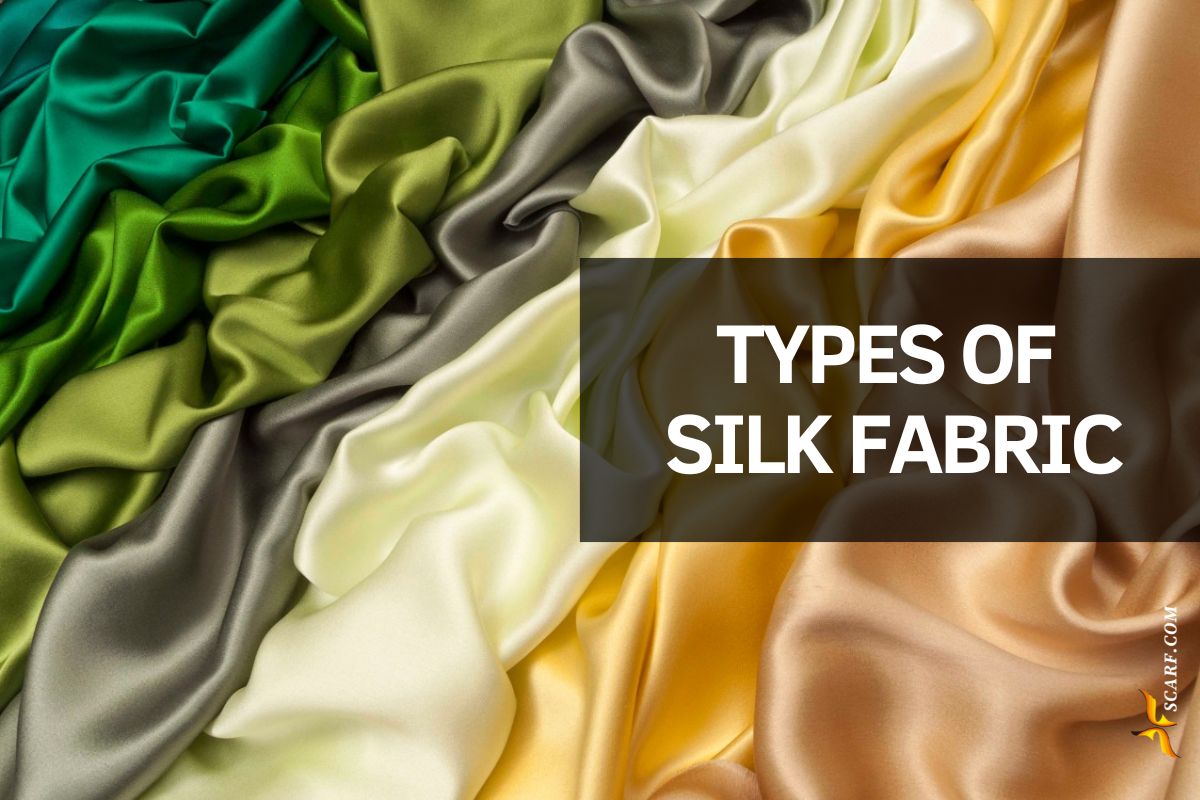You must know that silk is the most comfortable fabric. Silk can also be classified. There aredifferent types of silk fabric.
Silk can be roughly divided into several types according to different textures, luster, weight and weaving techniques: Silk Twill fabric, Silk Satin, Silk Chiffon, Silk crepe de chine fabric, Silk Organza fabric, Silk Habotai, Silk Georgette.
7 Different Types of Silk Fabric
Silk Twill fabric
What is silk twill?
Silk Twill is an elegant textile made of 100% silk in a twill weave. This medium-weight fabric works well for accessories like scarves. Digital printing opens up an entire world of possibilities with silk twill. It allows for beautiful, high-resolution prints.
Twill silk is made with a special weaving process that makes it soft, breathable and durable. Twill silk is stronger and more wrinkle-resistant than plain weave. Twill silk has a great drape, is light in weight and durable.
Silk Satin
The surface of satin silk is smooth and glossy. The satin weave is unique in that it skips some warp threads to allow longer weft threads to rest on the surface. This produces a smooth, shiny surface with a luxurious shine.
The softness and beauty of satin sheen are often featured in eveningwear. From lavish gowns to sophisticated, robes, it is a popular choice for fashion.
Avoid touching the front of satin directly with an iron. Instead, use a pressing fabric, a sharp, new sewing needle and ballpoint pins.
silk vs satin
Satin refers to a weave rather than a material. It can be made from various fibers, including silk, polyester, and nylon.
Satin has a glossy, smooth surface on one side and a matte finish on the other. The shine comes from the way the fibers are woven, creating a smooth, reflective surface.
While they often get confused with one another, silk and satin are not the same, with satin is usually presented as a less-luxurious alternative to real silk due to it being a man-made fabric.
Silk
Material Silk is a natural fibre produced by silkworms. Silk has a soft, smooth feel and a unique luster.
Properties Silk is known for strength, softness and natural sheen. It can be lightweight or heavy depending on the weave.
Types Silk can be made into a variety of fabrics including charmeuse and georgette. These fabrics have different textures and finishes.
Silk Care : Silk is delicate, and requires hand washing or drying to maintain quality.
Satin
Material : Satin is a weave, not a material. It is made of various fibers including nylon, polyester and silk.
Satin is a smooth, glossy surface on one end and matte on the other. The fibers’ weave creates a smooth and reflective surface.
Types Satin is made of silk (silk) or synthetic fibers. Silk satin is more expensive, while synthetic satins tend to be more durable and affordable.
Care : The care varies depending on the fiber. Silk satin requires delicate handling while synthetic satins are generally easier to maintain.
Silk Chiffon
What is silk chiffon?
Chiffon is a lightweight and sheer fabric that’s made using a plain weave of creped fibers – this means additional twist is added to the fibers during the weaving stage. The resulting fabric has a soft crinkle and is delicately floaty.
Chiffon is a common fabric in floaty blouses (or accents on blouses) as well as skirts and ethereal, layered dresses. It’s sheer so it should be layered or lined in a garment.
Silk crepe de chine fabric
The fabric is woven using a plain weave, but the weft yarns are creped and alternate between Z and S twists (which is just a technical way of saying they’re spun either clockwise or counterclockwise) – the resulting fabric has a unique textured finish that’s difficult to replicate. It has a subtle sheen that is less glossy than satin.
This unique fabric can be made in a variety of weights. Ideal for blouses, dresses, skirts, and scarves. Its drape makes it a popular choice for elegant and flowing garments.
Silk Organza fabric
Organza is a very lightweight, plain weave fabric that’s sheer and has a crisp, bouncy body. When laid flat, it looks similar to Georgette (but more transparent) and also to chiffon (but has much more body).
Organza silk material is often used in bridal and evening garments, especially those with more structure.
Requires gentle care to maintain its quality. It is typically recommended to hand wash or dry clean to prevent damage. If needed, iron on a low setting while the fabric is still slightly damp to avoid scorching.
Silk Habotai
What is habotai silk?
Habotai silk, often referred to as “China silk, “It’s made using a plain weave but it’s more densely woven than chiffon, and comes in a range of weights from tissue-thin to medium weight suitable for dresses and blouses. It’s less delicate because of its dense weave. It is less shiny than some other silk fabrics like satin, but it has a subtle sheen.
Habotai is more frequently seen in casual clothing or everyday items (like silk pillowcases and eye masks) as it’s so versatile, but it can also be used for couture dresses or even quilts and pillow.
Silk Habotai is popular in the world of arts and crafts, particularly for silk painting and dyeing, because it absorbs color beautifully and evenly.
Like most silk fabrics, it requires careful handling. Hand washing or dry cleaning is typically recommended to preserve its quality. If ironing is necessary, it should be done on a low setting while the fabric is still slightly damp to avoid damage.
Silk Georgette
Silk Georgette, a sheer lightweight silk fabric with a distinctive texture and drape, is known for its light weight. Georgette is a lightweight, sheer silk fabric with a pebbly or crinkled texture. This is due to the high twisting of the yarns in the weave. This texture is more prominent than silk crepe.
Georgette is a heavier, less transparent version of chiffon. It has a similar structure and weave, but it is heavier with a more fluid drape.
It is often used in blouses, dresses and evening gowns. Due to its flowing nature, it’s popular with garments that have a lot going on, such as ruffles or layers.
Handling is important. Dry cleaning is recommended for most pieces, but hand washing may be appropriate.
Georgette, despite its good drape, is less likely to wrinkle than other silk fabrics. Iron on low heat with a pressing towel to protect the fabric.
Georgette silk sarees are usually made of Georgette fabric. This can either be pure silk georgette, or a mixture of silk and synthetic fibers. The saree is made using the traditional Banarasi weave, which was developed in Varanasi. This technique is known as a result of its intricate patterns. It often uses zari threads (gold or silver) and elaborate designs that are inspired by Mughal Art.
After read this 7 different types of silk fabric, do you want to start your fabric business? Contact us now!
FAQ
What is the difference between silk twill and silk crepe?
Silk Twill and Silk Crepe differ primarily in texture and weave. Silk Twill has a distinct diagonal rib pattern due to its twill weave, making it smooth, durable, and slightly lustrous. It’s often used for scarves and ties. Silk Crepe, on the other hand, has a crinkled texture from highly twisted yarns, giving it a matte finish and a soft, flowing drape. It’s more delicate and is commonly used for dresses and blouses. The twill is sturdier, while crepe is softer and more textured.
Silk twill vs silk?
Silk Twill is a specific type of silk fabric with a diagonal rib pattern due to its twill weave, making it smooth, durable, and slightly shiny. It’s often used for scarves and ties. Silk refers to the natural fiber from silkworms and can be woven into various fabrics like satin, chiffon, or crepe. While all silk fabrics share a soft, luxurious feel, silk twill is particularly known for its durability and distinctive texture compared to other silk weaves.
Is a twill weave stretchy?
A twill weave itself is not inherently stretchy. Twill is characterized by its diagonal rib pattern, which provides durability and a bit of flexibility compared to plain weaves, but not actual stretch. However, if the fabric is made with elastic fibers (like spandex) or if it’s cut on the bias (diagonally across the weave), it can exhibit some stretch. Traditional twill fabrics, such as denim or silk twill, are generally sturdy and only slightly more flexible than plain weaves.
Does 100 silk wrinkle easily?
Yes, 100% silk tends to wrinkle easily. Silk is a delicate, natural fiber that lacks the elasticity needed to resist wrinkles. While its smooth surface and lightweight nature contribute to its luxurious feel, these qualities also make it prone to creasing. To minimize wrinkles, it’s best to handle silk garments carefully, avoid tight folding, and store them properly. Steam or low-heat ironing can help remove wrinkles when needed.
Where can make silk chiffon fabric wholesale?
Scarf.com offer varify types of fabric ,including silk chiffon. Come and consult to get the biggest discount.
What is the difference between organza and habotai?
Organza is a sheer, stiff silk fabric with a crisp texture, often used for overlays, wedding gowns, and decorative elements. It holds its shape well, making it ideal for structured garments. Habotai, also known as “China silk,” is a lightweight, smooth, and soft fabric with a subtle sheen. It’s more fluid and drapes well, commonly used for linings, blouses, and scarves. The key difference lies in organza’s stiffness versus habotai’s softness and drape.
ls habotai silk see through?
Habotai silk can be semi-sheer to opaque, depending on its weight. Lighter weights of Habotai silk are often somewhat transparent, while heavier weights provide more coverage. Its level of sheerness can be influenced by the fabric’s thickness and the way it’s used in garments. For applications where opacity is important, choosing a heavier weight or using it as a lining can help minimize transparency.
Does georgette shrink after washing?
Silk Georgette may shrink after washing, especially if not handled properly. To minimize shrinkage, it’s best to hand wash in cold water or use a gentle cycle with cold water in a machine, and avoid wringing. Dry the fabric flat or hang it to dry, avoiding high heat. Always check the care label for specific instructions to preserve the fabric’s quality and prevent unwanted shrinkage.
ls silk georgette good for summer?
Yes, silk Georgette is good for summer. Its lightweight and breathable nature makes it comfortable in warm weather. The fabric’s semi-sheer quality allows for good airflow, helping to keep you cool. However, because it’s delicate, it’s important to handle it carefully to maintain its appearance and feel.



